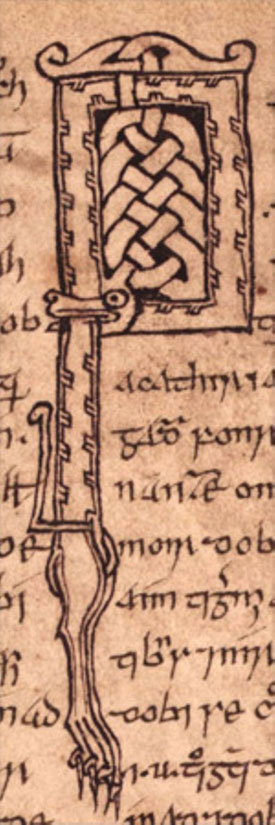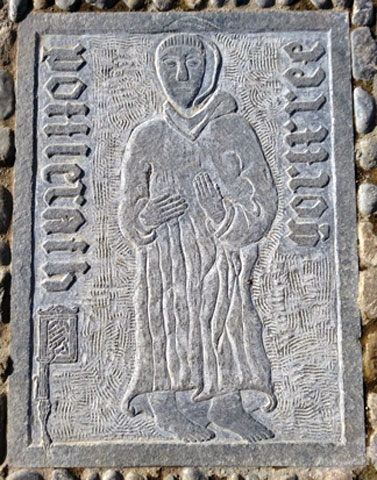Pottlerath and Gortfree
(a Fragment of Book of Pottlerath)
& EARLIEST RECORDS.

“This book is a famous copy of a great part of the Book of St. Mochuda of Cong, in which is contained many divine things, most of which documents the antiquities of the ancient houses of Ireland, a catalogue of their Kings, of the coming of the Romans into England, of the coming of the Saxons, and of their lives and regimes; a notable calendar of the Irish Saints of the Roman breviary until that time; a catalogue of the Popes of Rome; how the Irish and the English were converted to the Catholic faith; with many other things, as the reader may find, and so understanding what they contain let him remember. - Tully Conry”
Thus is recorded on a note pasted on the inside of the cover of a copy of the Psalter of Cashel written by Aengus Mac Nathfrach, King of Cashel, Copied in 1453 for Edmund Mac Richard Butler in Pottlerath by Seagan Buidhe O'Cleirigh. And now preserved in the Bodleian Library, Oxford.
The Story of Slieveardagh and its Christian heritage begins with the Baptism of Aengus Mac Nathfrach at Cashel. A celebrated anecdote is told about this King Aengus. It is said that when St Patrick was conferring the Sacrament of Baptism upon him he accidentently laid the crosier on the Kings foot. The crosier pierced his foot, causing it to bleed profusely. So great, however, was the Kings devotion, that he did not make any sign of uneasiness, but patiently bore the pain, thinking it was part of the ceremony. 'This crosier (the celebrated Irish relic known as the Bachal-Iosa, i.e., the Staff of Jesus) was preserved in Armagh until the English invasion (Cromwell) when it was brought to Dublin and kept at Christ Church Cathedral. But alas! At the time of the reformation it was publicly burned in the streets of the city'.
The first recorded missionary to Ireland was Palladius, who was probably from Gaul [France]. He was sent by the Pope to be bishop to the "Irish who believe in Christ". Patrick himself stated that Palladius' mission was a failure. However, other historical documents from outside Ireland indicate that the mission of Palladius was very successful, at least in Laigin (Leinster), and that he set up a number of churches. Tradition says that Palladius' visit to Ireland was in the year 431.
We are told in Historical Geographies that during the century before the Christian Era there was a regular movement of population between the districts now known as Munster and Leinster, by way of the gap 'between Slieveardagh and Slievenamon. The passage was one of the chief routes between Tara and Cashel. Later the district became the scene of many conflicts between the Norse men from Scandinavia and the native Irish. Later still it was frequently the battleground for the war-loving Ormonde and Geraldine landowners. Nowadays, happily, the rivalry between the sturdy combatants of the ancient principalities of Cashel and Ossory is exercised only on the hurling and football fields.
In the Ossory Archaeological Society publications, papers attributed to Dr James Lanigan (1779 -1812) Bishop of Ossory deal with the Parish of Kilmanagh. According to Dr. Lannigan there are two patron Saints of Kilmanagh -Saint Edán or Enda whose feast is assigned to the 31st Dec and St. Natalis, or Naul, - Nailé 'as Gaeilge', whose feast day is set down in the Martyrology (recorded calender of events) of Tallagh as the 31st July. It is very probable that St Nathalis was the son of Aengus Mac Nathfrach, King of Cashel (killed 490). Dr Lanigan says that little or nothing would be known about Nathalis were he not highly praised in the lives of St. Senan of Inniscathy (Scattery Island at the Mouth of the Shannon), who, when young, was a pupil of his, having been directed to his monastery by the Abbot Cassidus. This monastery was situated in Dún-Aengusa-Mac Nadfraich called after the first Christian King of Munster who resided in Cashel; was later known as Rath a'Photaire (Rath of the potter) later anglicized to Pottlerath a townland near the Munster River in Kilmanagh Parish, Co. Kilkenny.

This number must have increased very much, if there is any truth in the following story. It is written that the monks of Dún-Aengusa-Mac Nadfraich paid a visit to their brethren at the monastery of Gort-friogh - 'this is the town land of Gortfree beside The Munster River in Ballingarry Parish, the river divides the modern Parishes of Ballingarry and Kilmanagh - Counties Tipperary and Kilkenny - as well as the provinces of Munster and Leinster. According to local folklore the site of this monastery is at the location of an old graveyard now dis-used'. When they arrived there the Abbot observed he had forgotten his breviary. Word was immediately sent back from one to the other by the monks, whose long line reached Pottlerath about two miles distant, and the breviary was forthcoming without delay.
St Naul flourished about the year 520, his death is assigned to the 27th January 564. From the following references, found in the annals of the Four Masters, Pottlerath must have been a place of importance and distinction in ancient times.
Under the year 780 we read: “The fifteenth year of Donnchadh Maeloctraigh, son of Conall, Abbot of Kilcullen and scribe of Cill-manach, died.” At the year 802 “Lemnatha Cill-manach died”. In the year 843 “Beasal, son of Caingne, Abbot Cill-manach died.
According to Dr. John O Donovan, the ancient name of Pottlerath was Dun-Aengusa-Mac Nadfraich -i.e., the fort of Aengus Mac Nadfraich, the first Christian King of Munster. It is worthy of note and very significant too, that Naul, the patron saint of Kilmanagh, was son of this same prince; and also that a holy well, known as Tobernedaun, or St Enda's well, preserves the name of St Enda of Arran, whose sister, Sant, was wife of Aengus, and mother of St Naul. There are cures documented in the Ossory papers attributed to the waters of this well. These sites are on the South Eastern end of the Slieveardagh hills

James Butler, the 4th Earl of Ormond, was known as the White Earl. He had a great interest in archaeology and history. He started work on the manuscript in Kilkenny and when he died he left the manuscript, not to his son and heir, but to his nephew Edmund Butler of Pottlerath, son of Richard.
The book was completed in 1454. After a battle in Piltown which saw the Butlers defeated, the book was handed over to Thomas Fitzgerald, 8th Earl of Desmond, in ransom for Butler’s release.
It took several generations before the book was returned to the Butler family, probably as part of the dowry when the 9th Earl of Ormond married the daughter of the 10th Earl of Desmond. The book was eventually bequeathed to the Archbishop of Canterbury who was Chancellor of the University of Oxford. He in turn gave it to the University for the Bodleian Library in 1636.